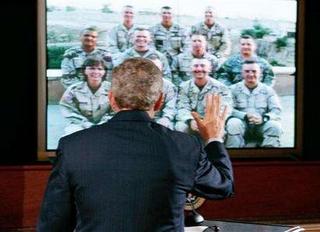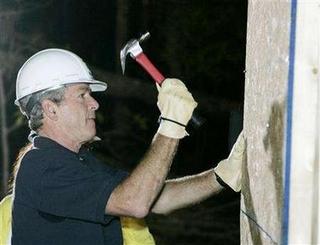Here's a clip from the WSJ piece referenced in the previous post. Sorry, can't verify directly as WSJ is subscription and expensive, but if you've got a subscription,
here's the direct link. (If this is not valid, let me know and I'll pull it down.)
Since then, her lawyers have told Patrick Fitzgerald, the special prosecutor investigating the leak of the CIA agent's identity, that Ms. Miller's notes show that she also spoke with Mr. Libby in late June, information that was not previously given to the grand jury.
Mr. Fitzgerald's pursuit now suggests he might be investigating not a narrow case on the leaking of the agent's name, but perhaps a broader conspiracy. .....
Lawyers familiar with the investigation believe that at least part of the outcome likely hangs on the inner workings of what has been dubbed the White House Iraq Group. Formed in August 2002, the group, which included Messrs. Rove and Libby, worked on setting strategy for selling the war in Iraq to the public in the months leading up to the March 2003 invasion. The group likely would have played a significant role in responding to Mr. Wilson's claims...
(coincidentally this is exactly word for word the same as the rawstory clip from last night. That's why I want to try and check it out.)
If Fitzgerald does get into the Iraq group, he would be deep in the core of those who were pushing the Saddam WMD claims. As Laura Rozen (bolds are hers) points out from
a WaPo article from AUG 2003.... (by the way,
I highly recommend Rozen's Blog, I almost always find something there that comes over here.)
...The escalation of nuclear rhetoric a year ago, including the introduction of the term "mushroom cloud" into the debate, coincided with the formation of a White House Iraq Group, or WHIG, a task force assigned to "educate the public" about the threat from Hussein, as a participant put it. ..... (WHIG was formed in August by Card - Mike)
The group met weekly in the Situation Room. Among the regular participants were Karl Rove, the president's senior political adviser; communications strategists Karen Hughes, Mary Matalin and James R. Wilkinson; legislative liaison Nicholas E. Calio; and policy advisers led by Rice and her deputy, Stephen J. Hadley, along with I. Lewis Libby, Cheney's chief of staff. .....
A "strategic communications" task force under the WHIG began to plan speeches and white papers. There were many themes in the coming weeks, but Iraq's nuclear menace was among the most prominent.
'A Mushroom Cloud'
The day after publication of Card's marketing remark, Bush and nearly all his top advisers began to talk about the dangers of an Iraqi nuclear bomb. ...
Two debuts took place on Sept. 8: the aluminum tubes and the image of "a mushroom cloud." A Sunday New York Times story quoted anonymous officials as saying the "diameter, thickness and other technical specifications" of the tubes -- precisely the grounds for skepticism among nuclear enrichment experts -- showed that they were "intended as components of centrifuges."
No one knows when Iraq will have its weapon, the story said, but "the first sign of a 'smoking gun,' they argue, may be a mushroom cloud." ...
A senior intelligence official said last October that the president's speechwriters took "literary license" with intelligence, a phrase applicable to language used by administration officials in some of the white paper's most emotive and misleading assertions elsewhere.
The draft white paper precedes other known instances in which the Bush administration considered the now-discredited claim that Iraq "sought uranium oxide, an essential ingredient in the enrichment process, from Africa." For a speechwriter, uranium was valuable as an image because anyone could see its connection to an atomic bomb. Despite warnings from intelligence analysts, the uranium would return again and again, including the Jan. 28 State of the Union address and three other Bush administration statements that month.
Other errors and exaggerations in public White House claims were repeated, or had their first mention, in the white paper.
I'll post more as I come across it.
UPDATE: I was just sitting here thinking about the other possible connections out of the Whitehouse Iraq Group, and let me postulate something for which I have no concrete backing.
The WHIG was getting it's intelligence data that it used to prop up it's questionable WMD claims from somewhere. Might I offer that the DoD's Office of Special Plans and its precurors might be one of the candidates.
From the award winning Mother Jones piece,
The Lie Factory. Remember, this is the outfit that Lt. Col. Karen Kwiatkowski outed a couple of years ago. And it was also the main entry point for "stovepiping" all the bad intelligence that Chalabi supplied.
The reports, virtually all false, of Iraqi weapons and terrorism ties emanated from an apparatus that began to gestate almost as soon as the Bush administration took power. In the very first meeting of the Bush national-security team, one day after President Bush took the oath of office in January 2001, the issue of invading Iraq was raised, according to one of the participants in the meeting‚ -- and officials all the way down the line started to get the message, long before 9/11. Indeed, the Bush team at the Pentagon hadn't even been formally installed before Paul Wolfowitz, the deputy secretary of Defense, and Douglas J. Feith, undersecretary of Defense for policy, began putting together what would become the vanguard for regime change in Iraq. ......
Daniel Benjamin, co-author of The Age of Sacred Terror, was director of counterterrorism at the National Security Council in the late 1990s. "In 1998, we went through every piece of intelligence we could find to see if there was a link between Al Qaeda and Iraq," he says. "We came to the conclusion that our intelligence agencies had it right: There was no noteworthy relationship between Al Qaeda and Iraq. I know that for a fact." Indeed, that was the consensus among virtually all anti-terrorism specialists. In short, Wurmser, backed by Feith and Rhode, set out to prove what didn't exist. ......
The purpose of the unnamed intelligence unit, often described as a Pentagon "cell," was to scour reports from the CIA, the Defense Intelligence Agency, the National Security Agency, and other agencies to find nuggets of information linking Iraq, Al Qaeda, terrorism, and the existence of Iraqi weapons of mass destruction (WMD). In a controversial press briefing in October 2002, a year after Wurmser's unit was established, Secretary of Defense Donald Rumsfeld acknowledged that a primary purpose of the unit was to cull factoids, which were then used to disparage, undermine, and contradict the CIA's reporting, which was far more cautious and nuanced than Rumsfeld, Wolfowitz, and Feith wanted. .....
But Luti was more than that. He'd come to the Pentagon directly from the office of Vice President Cheney. That gave Luti, a recently retired, decorated Navy captain whose career ran from combat aviation to command of a helicopter assault ship, extra clout. .....
Besides Cheney, key members of the Pentagon's Defense Policy Board, including Perle and ex-House Speaker Newt Gingrich, all Iraq hawks, had direct input into NESA/OSP.











